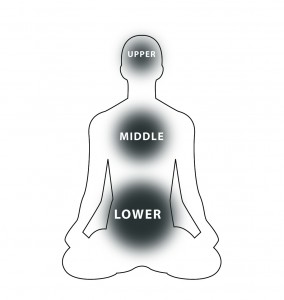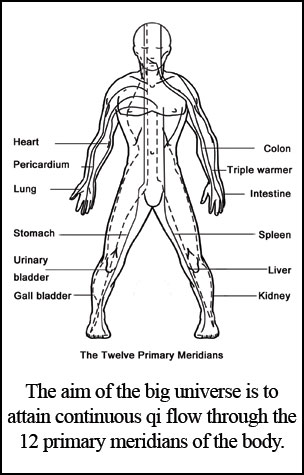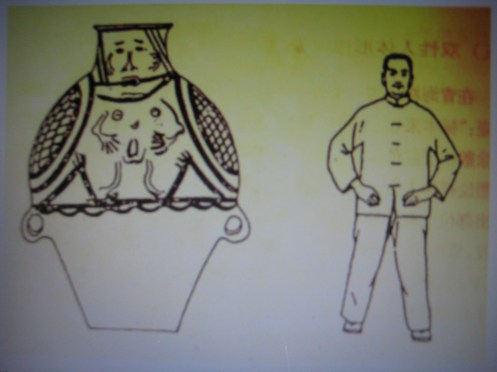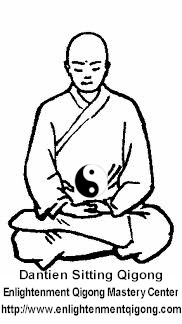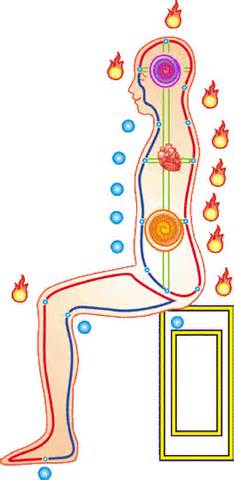Qi Gong: Developing Axial Consciousness
Traditionally, the central focus of qigong practice is to cultivate and balance qi as it affects mind (心), body (身), and spirit (靈). (Liu, JeeLoo. An Introduction to Chinese Philosophy: From Ancient Philosophy to Chinese Buddhism. Wiley-Blackwell./ Frantzis, Bruce Kumar (1995). Opening the Energy Gates of Your Body (The Tao of Energy Enhancement). North Atlantic Books.)
In Chinese philosophy, the concept of qi as a form of pervasive life energy includes original qi that a person has at birth, and qi a person acquires from air, water, food, sunlight, and interaction with the environment. (Liu, JeeLoo. An Introduction to Chinese Philosophy: From Ancient Philosophy to Chinese Buddhism. Wiley-Blackwell./ Li, Chenyang (1999). The Tao encounters the West: explorations in comparative philosophy. Albany: State University of New York Press.) A person is believed to become ill or die when qi becomes diminished or unbalanced. Health is believed to be returned by rebuilding qi, eliminating qi blockages, and correcting qi imbalances.
Traditional Chinese medicine focuses on tracing and correcting underlying disharmony, in terms of deficiency and excess, using the complementary and opposing forces of yin and yang, to create a balanced flow of qi. Qi is believed to be cultivated and stored in three main dantian energy centers and to travel through the body along twelve main meridians, with numerous smaller branches and tributaries. The main meridians correspond to twelve main organs (Zàng fǔ).
Qi Gong as a physical health practice, presented by the contemporary Chinese and Westerners, is a complex accretion of the ancient Chinese meditative practice xing qi 行氣 or “circulating qi,” and gymnastic exercise daoyin 導引 or “guiding and pulling… The tradition of the meditative practices and gymnastic exercises goes back a long way in Chinese history. The first source, and the earliest evidence of the meditative practice and gymnastic exercise is the discovery of the Neolithic vessel in the early 1980s in Northwest China. The pottery is identified as a Shamanic vessel. The image on the nearly 7000 year old pottery, archaeologists suggest, represents the hermaphroditic unity of wu xi 巫覡, or the priest-shaman… Since the image of the body posture on the pottery is identical to the posture of the essential meditative practice or gymnastic exercise, the Chinese Qi Gong historian Li Zhiyong 李志庸 contends that the priest-shamans were the earliest masters of the Chinese meditative practice and gymnastic exercise. The Harvard anthropology professor K. C. Chang not only agrees with Li, but also suggests that the meditative practice and gymnastic exercise might have been the essential method for the priest-shamans to arrive at the state of trance/ecstasy. (Chang, 145) In addition, the French sinologist Catherine Despeux also traces the meditative practice and gymnastic exercise back to the ancient shamanic techniques of ecstasy. She sums up the studies of the Marcel Granet and Maxime Kaltenmark, which trace the shamanic origins of the legendary immortals Pengzu 彭祖, Chisongzi 赤松子, the masters of the wind and the rain, and the animal-bird dances. Despeux concludes: “the gymnastic exercises are a later development of original shamanic techniques.” (Despeux, 239) (YeYoung, Bing. “Origins of Qi Gong”. YeYoung Culture Studies: Sacramento, CA From: http://literati-tradition.com/qi_gong_origins.html)
Zhuangzi specifies: “Zhenren 真人, or the True Man’s food is plain, but his breathing is unfathomable and tranquil. While the breathing of mass is through their throats, the breathing of the True Man is through his heels.” (Guo, 228) Zhuangzi conceives such training for the Way by refining and energizing qi in controlling one’s posture and breathing. (YeYoung, Bing. “Origins of Qi Gong”. YeYoung Culture Studies: Sacramento, CA From: http://literati-tradition.com/qi_gong_origins.html)
Taoist and Buddhist teachers often instruct their students to center the mind in the navel or lower dantian. This is believed to aid control of thoughts and emotions. Acting from the dantian is considered to be related to higher states of awareness or samadhi.
Qi is cultivated in the dantian. The energy from other subtle dimensions enters the physical realm at the dantian.
The lower dantian corresponds to the yoga concept of the swadhisthana chakra. In yoga philosophy, it is thought to be the seat of prana that radiates outwards to the entire body. (T’ai Chi Ch’uan and Meditation by Da Liu, pages 91-92 – Routledge and Keegan Paul 1987)
Earth energy and heaven energy meet in the lower dantian.
The body’s vitality is called jing centered in the lower dantian. The power that makes mental activity possible is called Qi. The energy of the heart is called shen. All three spread throughout the whole body. The relationship between them can be compared to a candle. Jing is the candlestick, Qi is the flame, and Shen is the light that emanates from the flame. The flame becomes greater when the candlestick is bigger. The light is brighter when the flame is greater. (http://www.qiwithoutborders.org/hara.html)
One must cultivate their jing(vitality) in the lower dantian(below navel) in order to attain more qi. The more qi one accumulates, the greater their heart will radiate. This is the unification of qi(breath/spirit) with jing(vitality/earth) to create shen(love/heart).
The three dantian are also known as the “Cinnabar Fields”.”
In Yin Xi’s biography in the Lishi zhenxian tidao tong jian, j. 8, “yin Xi zhuan” we find the following passage: Yin Xi asked Laozi: “Purifying gold and absorbing breath, can the Tao be dichotomous in the way?” Laozi replied: “The floreate essence of Heaven and Earth, the root of Yin and Yang, is what is known as the two qi (breath, pneuma). The Yang dragon and Yin tiger, the liquid of wood and the essence of metal, take their two qi and unite them; the product obtained upon purification is what is called the outer elixir (waidan). Keep it within and purify the viscera, expel the old [breath] and introduce the new, conduct it up to the Nihuan (upper field of cinnabar), make it descend and concentrate in the lower cinnabar field, circulate it non-stop until it goes to audience in the scarlet palace (heart, middle field of cinnabar). (Baldrian Hussein, Farzeen. “Inner Alchemy: Notes on the Origin and Use of the Term neidan.” Cahiers d’Extreme-Asie 5.1 (1989): 172).
The three places in the human body where neurons are most concentrated are the brain, the heart, and the gut. When all three work in unison the result is axial consciousness.
“Our true consciousness, the consciousness into which humanity is evolving, does not lie in either the pole of the head or the pole of the belly. Our true consciousness is a field sustained by the axis that runs between those poles – as the poles of a bar magnet sustain a magnetic field around it. Before we can grow into an axial consciousness, though, we have to reclaim what we abandoned so long ago: the female genius of being, which resides in the belly.” (Shepherd, Philip New Self, New World: Recovering Our Senses in the Twenty-First Century North Atlantic Books 2010)

